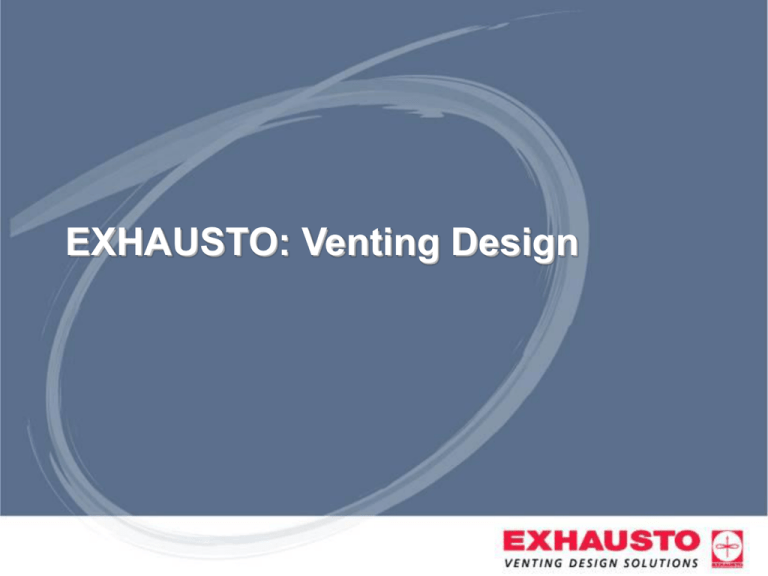Chimney Automation System
advertisement

EXHAUSTO: Venting Design Appliance Categories ASHRAE Equation & Chimney Pressures Common Code Violations Chimney Automation Systems Combustion Air Supply Boiler Room Simulator Overdraft Damper System Dryer Venting Appliance Categories • ANSI Venting Categorization Sub Title Appliance Categorization Atmospheric Draft Hood Fan Assisted Scotch Marine Draft Diverter I Negative Forced Draft Sub Title Fan Assisted (high efficiency) II III IV Condensing Positive Acceptable Venting Material Atmospheric Fan Assisted Forced Draft B-Vent B-Vent UL103 P-Stack Masonry Masonry (interior) Welded Steel I Negative III Sub Title Fan Assisted (85+ efficiency) AL29-4C double wall Condensing II IV (85 – 90 % efficiency) (90+ efficiency) AL29-4C double wall AL29-4C single wall Positive CPVC (tested with appliance) Masonry Chimney Liners Reference: ANSI Z223.1-2002 10.4.1 and 13.1.9, NFPA211 4-2.2 •Atmospheric Clay tile liner •Fan Assisted •Forced Draft Clay tile liner (interior chimney) Positive pressure steel liner Ex. Welded steel, Inner liner of pressure stack Steel liner (exterior chimney) Exception: Clay tile liner can be used with exterior chimney if an Atmospheric appliance is connected to the same chimney Negative Sub Title I III Positive •Fan Assisted II IV •Condensing (85+ efficiency) AL29-4C Liner AL29-4C Liner Chimney Design Equation 1996 Edition INPUTS: • • • • • • • • Appliance Type Fuel Type MBH Input CO2% in Flue Gases Flue Gas Temperature Ambient Temperature Altitude Flue Layout Theoretical Draft (-) Sub Title RESULTS: • • • • • Flue Gas Volume Flue Gas Velocity Theoretical Draft Total Pressure Losses Appliance Outlet Pressure Pressure Losses (+) + Outlet Pressure Boiler Efficiency versus Draft Sub Title Annual Draft Variations Sub Title Chimney Draft – Steady-State Sub Title Draft Variations During Operation Vent = 30’ vert./10’ horiz., 18” diam. 4 Fan-assisted Cat I boilers with 1,000 MBH input each Constant ambient of 60°F Sub Title Draft requirement: 0.05”WC Modulating Boiler Systems Gravity Stack Design Sub Title Chimney Automation Systems Sub Title CASV – Chimney Automation System Sub Title CASI – Chimney Automation System Sub Title Modulating Boiler Systems Controlled Draft Design Sub Title First Cost Analysis Ordinary Stack Material Cost EXHAUSTO System Material Cost Item Qty Item Qty List Price 20" pressure stack 35' $ 5,775 12" pressure stack 50' $ 4,600 16" pressure stack 5' $ 630 12" Tee 1 $ 345 14" pressure stack 5' $ 535 12" end cap 2 $ 260 10" pressure stack 5' $ 405 12" x 8" reducing Tee 4 $ 1,240 20" Tee 1 $ 610 20 " end cap 1 $ 205 Sub Title 20" x 16" tapered reducer 1 $ 410 1 $ 360 16" x 8" reducing Tee 1 $ 355 16" x 14" tapered reducer 1 $ 280 14" x 8" reducing Tee 1 $ 335 14" x 10" tapered reducer 1 $ 245 10" x 8" reducing Tee 1 $ 295 10" end cap 1 $ 130 20" stack cap 1 $ 640 20" x 8" reducing Tee Total List Price $ 11,210 Total $ 6,445 National Fuel Gas Code • • • • • • • Horizontal distances Large stack area Self venting connector rise Fan Min capacities Different type of Sub Title appliances Existing masonry chimneys Location of draft inducer NFPA 54 IFGC ANSI Z 223.1 Common Code Violations Chimney Automation System Sub Title (NFPA 54) Z223.1-2002 (Venting of Equipment) 10.6.1.4 The total horizontal distance of a vent plus the horizontal vent connector serving draft hood-equipped appliances shall not be greater than 75 % of the vertical height of the vent. Table 13.1 and 13.2 The total horizontal length of the vent plus the vent connector for a single Category I appliance is: 100% of the height (vent 6 – 30 ft high); 30 ft (vent 31 – 50 ft high); 50% of the height (vent 51 – 100 ft high) Common Code Violations 3" 4" 5" 6" 7" 8" 9" 10" 12" 14" 16" 18" 20" 22" 24" 4.5' 6' 7.5' 9' 10.5' 12' 13.5' 15' 18' 21' 24' 27' 30' 33' 36' Chimney Automation System Sub Title (NFPA 54) Z223.1-2002 13.2 (Sizing of Venting Systems) 13.2.2 The maximum vent connector horizontal length shall be 18 in./in of connector diameter. 13.2.4 The length of the common vent manifold shall not exceed 18 in./in. of common vent diameter. 13.2.5 The horizontal length of the common vent offset shall not exceed 18 in./in. of common vent diameter. Common Code Violations 3" 4" 5" 6" 7" 8" 9" 10" 12" 14" 16" 7" 10" 12" 14" 18" 22" 22" 26" 30" 36" 42" Chimney Automation System Sub Title (NFPA 54) Z223.1-2002 13.2.17 (Sizing of Venting Systems) 13.2.17 Where two or more appliances are connected to a vertical vent or chimney, the flow area of the largest section of vertical or chimney shall not exceed seven times the smallest listed appliance categorized vent areas, flue collar area, or draft hood outlet area unless designed in accordance with approved engineering methods. Common Code Violations Chimney Automation System Sub Title (NFPA 54) Z223.1-2002 10.10.4.2 (Venting of Equipment) 10.10.4.2 Vent connectors serving Category I appliances shall not be connected into any portion of mechanical draft systems operating under positive static pressure, such as those serving Category III or Category IV appliances. Side-wall Venting Sub Title Z223.1-51-2002 (Venting of Equipment) 10.3.4.6 Mechanical Draft Systems. The exit terminals of mechanical draft systems shall be not less than 7ft above grade where located adjacent to public walkways. Side-wall Venting Sub Title Z223.1-56 (Venting of Equipment) 7.8 Venting System Location. (a) A Venting system shall terminate at least 3 ft (0.9 m) above any forced air inlet located within 10 ft (3.1 m). Exception No. 1: This provision shall not apply to the combustion air intake of a direct-vent appliance. Exception No. 2: This provision shall not apply to the separation of circulating air inlet and flue gas discharge of listed outdoor appliances. Side-wall Venting Sub Title Z223.1-56 (Venting of Equipment) 7.8 Venting System Location. (b) The venting system of other than a direct-vent appliance shall terminate at least 4 ft (1.2 m) below, 4 ft (1.2 m) horizontally from, or 1 ft (30 cm) above any door, window, or gravity air inlet into any building. The bottom of the vent terminal shall be located at least 12 in. (30 cm) above grade. Roof-top Venting Sub Title Z223.1-56 (Venting of Equipment) Gravity Stack Terminations Sub Title NFPA Fig. 12a NFPA Fig. 12b Gravity Stack Terminations Experience Shows Hypotenuse of two obstruction edges Hypotenuse of two obstruction edges 2 ft above hypotenuse Sub Title More than 10 ft 2 ft above hypotenuse Mechanical Draft Systems Defined Z223.1-2002 Standard for Venting of Equipment 10.3.4.1 Mechanical draft systems shall be listed and shall be installed in accordance with the terms of their listing and both the appliance and the mechanical draft system manufacturer’s instructions. 10.3.4.2 Gas utilization equipment requiring venting shall be permitted to be vented by Sub Title draft systems of either forced or induced draft design. means of mechanical Exception: Incinerators 10.3.4.5 Where a mechanical draft system is employed, provision shall be made to prevent flow of gas to the main burners when the draft system is not performing so as to satisfy the operating requirements of the equipment for safe performance Mechanical Draft Systems Defined IFGC - Section 503 (Venting of Equipment) 503.6.9.3 Mechanical draft. Chimney venting systems using mechanical draft shall be sized in accordance with approved engineering methods. Z223.1-2002 Standard for Venting of Equipment Sub Title 10.5.3.1 Size of Chimneys. Chimney venting systems using mechanical draft shall be sized in accordance with approved engineering methods. CASV – Chimney Automation System Sub Title CASI – Chimney Automation System Sub Title RSIB – Power Venter • • • • Sub Title • • • • • • SS16 construction Removable access door Direct drive Class A insulated motor - eliminates the need for secondary fan cooling Maintenance free 575 ºF Continuous Duty UL 378 – Draft Equipment The RSIB fan can vent category I, II, III and IV appliances with or without barometric dampers Simple design with few components reduces the risk of failure and simplifies service RSIB is of Type B, Spark Resistant Construction Installation Options - RSIB Sub Title CASV Applications – Stack Downsizing Sub Title Hazen High School – Renton, WA Soldier Field - Chicago, IL CASV Applications - Aesthetics Getty Center – Los Angeles, CA Sub Title Rigel – South San Francisco, CA CASV Applications - Aesthetics SBC Center – San Antonio, TX Sub Title CASV Applications Sub Title MODS Modulating Overdraft Damper System Modulating Overdraft Damper System Sub Title MODS Components • Sub Title MDF Damper Sizes – 12 in. to 48 in. diameters Multiple opposed blades made of 16 gauge type 316 stainless Pressure stack flange connections Rated to 700°F EBC30 Prime function Additional over-pressure protection for Forced-draft boilers MODS Applications Kaiser Center - Oakland, CA Wells Fargo - Great Falls, MT Sub Title Markham Road - Toronto MCAS Mechanical Combustion Air Supply Codes and Standards Code Requirements – Air for Combustion and Ventilation • Z223.1-2002 8.3.3 Outdoor Combustion Air. 8.3.3.1 Two Permanent Openings Method. Two permanent openings, one commencing within 12 in. of the top and one commencing within 12 in. of the bottom of the enclosure, shall be provided. The openings shall communicate directly, or by ducts, with the outdoors or spaces that freely communicate with the outdoors as follows: Sub Title (1) Where directly communicating with the outdoors or through vertical ducts, each opening shall have a minimum free area of 1 in.²/4000 Btu of total input rating of all equipment in the enclosure. (2) Where communicating with the outdoors through horizontal ducts, each opening shall have a minimum free area of not less than 1in.²/2000 Btu of total input rating of all equipment in the enclosure Codes and Standards Code Requirements – Air for Combustion and Ventilation • Z223.1-2002 8.3.3 Outdoor Combustion Air. 8.3.3.2 One Permanent Opening Method: One permanent opening, commencing within 12 in. of the top of the enclosure, shall be provided. The opening shall directly communicate with the outdoors or shall communicate through a vertical or horizontal duct to the outdoors or spaces that freely communicate with the outdoors and shall have a minimum free area of the following: Sub Title (1) (2) 1 in.²/3000 Btu of the total input rating of all equipment located in the enclosure, and Not less than the sum of the areas of all vent connectors in the space. Codes and Standards Sizing of Gravity Louvers Louver(s) Sizing: • 1 sq.in./4000 Btu per louver 4000 MBH = 1000 in2 of free area per louver. • Typical louver has 30-60% free area. • Depending on louver design actual louver size will be: Using 45% free area louvers = Two 5’ x 4’ louvers Sub Title 2000 MBH 2000 MBH Codes and Standards Code Requirements – Air for Combustion and Ventilation – Mechanical Combustion Air Supply (MCAS) • Z223.1-2002 8.3.6 Mechanical Combustion Air Supply. Where all combustion air is provided by a mechanical air supply system, the combustion air shall be supplied from outdoors at the minimum rate of 0.35 ft³/min per 1000 Btu/hr for all appliances located within the space. Sub Title 8.3.6.1 Where exhaust fans are installed, additional air shall be provided to replace the exhausted air. 8.3.6.2 Each of the appliances served shall be interlocked to the mechanical air supply system to prevent main burner operation where the mechanical air supply system is not in operation. Codes and Standards Sizing of Mechanical Combustion Air Louver Sizing: • Engineered using ASHRAE Chimney Design Equation. Sub Title • Flue Gas Volume corrected for temperature = 1,400 cfm of combustion air • 1400 cfm/500 fpm = 2.8 ft2 of louver free area 2000 MBH 2000 MBH • Using a 45% free area louver = One 3’ x 2’ louver MCAS – Modulating Combustion Air Supply System Sub Title MCAS Components – BESF/BESB Fan Seven Models 450 – 5500 cfm Sub Title Fan can be mounted indoors or outdoors. Impeller - statically and dynamically balanced. Insulated housing in galvanized steel Hinged fan housing easily opens to provide easy access to duct and impeller Direct drive, variable speed, TEFC motor located outside housing for easy access. Variable Frequency Drive is used on three phase models (VFD should be located inside the building). MCAS Components – SFTA Fan Seven Models 1,500 – 30,000 cfm Sub Title Fan can be mounted indoors Impeller – cast allunimum. Housing in steel Direct drive, variable speed, TEFC motor located outside housing for easy access. Variable Frequency Drive is used on three phase models (VFD should be located inside the building). EBC30 Modulating Control Chimney Automation System Sub Title Modulating Combustion Air Supply System MCAS Mechanical Combustion Air Supply SBC Center – San Antonio, TX Sub Title Two 16 inch ducted combustion air inlets Instead of Two 10 foot high by 15 foot long Louvers Lifetime Fitness – Savage, MN Sub Title Marriott Waterfront – Annapolis, MD Sub Title One 24 inch ducted combustion air Instead of one 90 ft.² louver MDVS Modulating Dryer Venting System Types of Clothes Dryers • Type 1 dryers: “Domestic” dryers to be used primarily in a family living environment. • Residences • Individual apartments or condominiums • Type dryers: Sub2 Title “Public” dryers designed to be used in business with direct intercourse of the function with the public. • Laundromats • Laundry rooms (apartment complexes, dormitories, etc.) • Business laundries (hotels, hospitals, health clubs, etc.) Typical Dryer Manufacturer’s Requirements • • • Where possible use a single exhaust duct per dryer Dryers are to run with a positive outlet pressure. • Type 1 dryers between +0.10 and +0.90 inch W.C. •Sub Type 2 dryers between +0.10 and +0.30 inch W.C. Title Maximum exhaust duct length: • Type 1 dryers = 35 equiv. feet (each elbow = 5 feet) • Type 2 dryers = 15 equiv. feet (each elbow = 5 feet) Typical Dryer Manufacturer’s Requirements for Multiple Dryers • Vertical venting must not exceed 8 feet and can include up to 3 elbows • Horizontal venting cannot exceed 15 feet and 1 elbow. Sub Title Common Exhausting of Multiple Dryers • • • • Common horizontal duct diameter is sized with maximum 0.10 inch W.C. pressure drop Pressure drop in main exhaust shaft is only limited by fan’s total pressure capability Cleanouts must be provided in the common horizontal as well as the main exhaust shaft for removal of lint Sub Title The BESB fan can be located anywhere downstream of the last dryer Use an MDVS for Multiple Dryer Exhausting Multistory exhausting of dryers Sub Title Common exhausting of multiple dryers Multistory Exhausting of Dryers • • • Type 1 or Type 2 dryers If main exhaust shaft does not need to be fire rated – attach connector to main shaft at 45° as previously shown If main exhaust shaft does need to be fire rated – attach connector via a 22 inch subduct riser as shown • Main exhaust shaft and subduct riser must be made of appropriate materials to meet local codes • In order to offset the subducts, a square or rectangular main exhaust shaft should be considered Sub Title Main Issues when Common Exhausting Dryers • For multistory dryer systems where the 22 inch subduct is used to maintain fire rating, a fan MUST BE USED and it must be in operation at all times to comply with code requirements • IBC 2006 Sub Title 716.5.3 Penetrations of shaft enclosures. Shaft enclosures that are permitted to be penetrated by ducts and air transfer openings shall be protected with approved fire and smoke dampers installed in accordance with their listing. Exceptions: 1. Fire dampers are not required at penetrations of shafts where: 1.1 Steel exhaust subducts extend at least 22 inches (559 mm) vertically in exhaust shafts pro-vided there is a continuous airflow upward to the outside. 2. In Group B and R occupancies, equipped throughout with and automatic sprinkler system in accordance with Section 903.3.1.1 smoke dampers are not required at penetrations of shafts where: 2.1. Kitchen, clothes dryer, bathroom and toilet room exhaust are installed with steel exhaust subducts, having a wall thickness of 0.019(0.48 mm); and 2.2 That extend at least 22 inches vertically; and 2.3 An exhaust fan is installed at the upper terminus of the shaft, that is powered continuously in accordance with Section 909.11, so as to maintain a continuous upward airflow to the outside. Multistory Exhausting of Dryers • • • Main exhaust shaft is made of smooth (firerated) material Main exhaust shaft sized to max 0.10 inch W.C. pressure drop Access door or cleanout to be located at bottom of main exhaust shaft for lint removal Sub Title • BESB fan can be located anywhere above top most dryer MDVS versus Single Speed MDVS • • • Single Speed ETL Listed mechanical dryer exhaust system • Usually runs at low rpm = low power • Sub Title Uses little to no conditioned air = low additional building heat or A/C • No listing for lint-laden air Runs at full rpm 24 hr/day X 365 days/yr = high power Uses a large quantity of conditioned air = large additional building heat and A/C MDVS versus Single Speed 20 Dryer Multistory Apartment 200 cfm X 20 X 50% = 2000 cfm MDVS Fan Power Single Speed Savings 41 KW/yr $4 /yr 4368 KW/yr $437 /yr $434 /yr Loss of heated air 1,454,200 (BTU/yr) $15 /yr 155,520,000 (BTU/yr) $1,555 /yr $1540 /yr Loss of A/C air (sensible only) 824,100 (BTU/yr) $5 /yr 88,128,000 (BTU/yr) $557 /yr $552 /yr Sub Title Location = Atlanta, GA (3000 DDH, 1700 DDC) Power = $0.10 per KW/h Heating = $1.00 per therm A/C = .75 KW/ton X $0.10 per KW/h Total Annual Savings = $2526 MDVS – Mechanical Dryer Venting System Sub Title MDVS Components - BESB Fan Four Models 1200 – 5500 cfm Sub Title • • • • Cast aluminum, backward curved impeller reduces lint build-up. Statically and dynamically balanced with permanently attached balancing weights. Insulated hinged fan housing easily opens to provide easy access to duct and impeller Direct drive with variable speed TEFC motor located outside housing for easy access. Frequency drive should be located inside the building. ETL Listed to UL705 with special consideration for operation with lint-laden air Mechanical Dryer Venting Systems Sub Title MCAS Modulating Combustion Air Supply for Dryers Why MCAS for Dryers? Make-Up Air. • Z223.1-2002 9.4 Clothes Dryers. Sub Title 9.4.3.2 Provisions for Make-Up Air. Provisions for make-up air shall be provided for Type 2 clothes dryers, with a minimum free area of 1 sq.in. for each 1000 Btu per hr total input rating of the dryer(s) installed. Manufacturer’s Requirement • • • National Fuel Gas Code requires a minimum free area opening of 1 sq.in./1000 Btuh Most manufacturers require even larger – approximately 1 sq.in / 700 Btuh. Ex. A twin 30# tumbler dryer with a total input of 204,000 Btuh (1100 cfm) requires a minimum 2 sq.ft. free area opening. Most laundry facilities have problems with make-up air. The industry believes it is one of their biggest problems. Sub Title MCAS Components – SFTA Fan Seven Models 1,500 – 30,000 cfm Sub Title Fan can be mounted indoors Impeller – cast allunimum. Housing in steel Direct drive, variable speed, TEFC motor located outside housing for easy access. Variable Frequency Drive is used on three phase models (VFD should be located inside the building). Marriott Waterfront – Annapolis, MD Sub Title One 24 inch ducted combustion air inlet Instead of One 90 ft.² louver Simulators CASV / MCAS MDVS Sub Title





